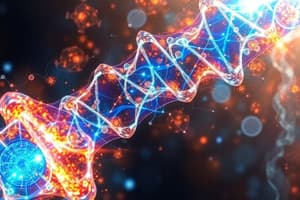Podcast
Questions and Answers
What is the name given to reactions in which electrons are transferred from one atom to another?
What is the name given to reactions in which electrons are transferred from one atom to another?
Oxidation-reduction reactions
Atoms that lose electrons are being reduced.
Atoms that lose electrons are being reduced.
False (B)
Which of the following is NOT a characteristic of oxidation?
Which of the following is NOT a characteristic of oxidation?
- The oxidation number of an element increases.
- A half-reaction has electrons as products.
- A compound adds oxygen.
- A compound gains hydrogen. (correct)
- An element loses electrons.
What is the study of redox reactions that produce or require an electric current?
What is the study of redox reactions that produce or require an electric current?
What type of cell is used to carry out the conversion between chemical energy and electrical energy?
What type of cell is used to carry out the conversion between chemical energy and electrical energy?
Where do spontaneous redox reactions take place?
Where do spontaneous redox reactions take place?
How can nonspontaneous redox reactions be made to occur?
How can nonspontaneous redox reactions be made to occur?
What is the name given to the electrode where oxidation takes place?
What is the name given to the electrode where oxidation takes place?
In a galvanic cell, the anode is connected to the negative end of the battery.
In a galvanic cell, the anode is connected to the negative end of the battery.
The cathode is the electrode where electrons are consumed.
The cathode is the electrode where electrons are consumed.
What is the purpose of the salt bridge in a voltaic cell?
What is the purpose of the salt bridge in a voltaic cell?
What is the shorthand notation for a voltaic cell?
What is the shorthand notation for a voltaic cell?
What is the name for the type of electrode that does not participate in the reaction but facilitates electron transfer?
What is the name for the type of electrode that does not participate in the reaction but facilitates electron transfer?
Under standard conditions, zinc has a weaker tendency to oxidize than copper.
Under standard conditions, zinc has a weaker tendency to oxidize than copper.
In a voltaic cell, where do electrons flow?
In a voltaic cell, where do electrons flow?
What is the primary electrolyte used in the Leclanché acidic dry cell?
What is the primary electrolyte used in the Leclanché acidic dry cell?
Leclanché acidic dry cells are rechargeable.
Leclanché acidic dry cells are rechargeable.
What is the key difference between acidic dry cells and alkaline dry cells?
What is the key difference between acidic dry cells and alkaline dry cells?
Alkaline dry cells are rechargeable and have a longer shelf life than acidic dry cells.
Alkaline dry cells are rechargeable and have a longer shelf life than acidic dry cells.
What is the electrolyte used in a lead storage battery?
What is the electrolyte used in a lead storage battery?
Which of the following is NOT an advantage of NiCad batteries?
Which of the following is NOT an advantage of NiCad batteries?
What is the primary electrolyte used in NiCad batteries?
What is the primary electrolyte used in NiCad batteries?
Lithium-ion batteries are non-rechargeable.
Lithium-ion batteries are non-rechargeable.
What is the primary characteristic that distinguishes fuel cells from traditional batteries?
What is the primary characteristic that distinguishes fuel cells from traditional batteries?
What type of metal is commonly used as a coating for both the anode and cathode in a hydrogen-oxygen fuel cell?
What type of metal is commonly used as a coating for both the anode and cathode in a hydrogen-oxygen fuel cell?
What is the electrolyte used in a hydrogen-oxygen fuel cell?
What is the electrolyte used in a hydrogen-oxygen fuel cell?
In all types of electrochemical cells, reduction takes place at the anode.
In all types of electrochemical cells, reduction takes place at the anode.
In voltaic cells, the anode is negatively charged.
In voltaic cells, the anode is negatively charged.
In voltaic cells, the cathode is positively charged.
In voltaic cells, the cathode is positively charged.
In electrolytic cells, the cell potential (Ecell) is positive.
In electrolytic cells, the cell potential (Ecell) is positive.
What is the process of using electrical energy to break a compound apart?
What is the process of using electrical energy to break a compound apart?
Electrolysis is always carried out in a voltaic cell.
Electrolysis is always carried out in a voltaic cell.
Electrolytic cells can be used to separate elements from their compounds.
Electrolytic cells can be used to separate elements from their compounds.
What is the primary source of energy used in electrolysis?
What is the primary source of energy used in electrolysis?
What are the two main types of electrolytes used in electrolytic cells?
What are the two main types of electrolytes used in electrolytic cells?
Cations in the electrolyte are attracted to the anode.
Cations in the electrolyte are attracted to the anode.
Anions release electrons to the anode and are oxidized.
Anions release electrons to the anode and are oxidized.
What is the overall reaction that occurs during the electrolysis of aqueous sodium chloride?
What is the overall reaction that occurs during the electrolysis of aqueous sodium chloride?
What is the overall reaction that occurs during the electrolysis of molten sodium chloride?
What is the overall reaction that occurs during the electrolysis of molten sodium chloride?
What is the name of the electrolytic cell commonly used for the production of sodium metal?
What is the name of the electrolytic cell commonly used for the production of sodium metal?
In electroplating, the work piece is the anode.
In electroplating, the work piece is the anode.
The anode in electroplating is made of the plating metal.
The anode in electroplating is made of the plating metal.
What is the process of purifying a metal using electrolysis?
What is the process of purifying a metal using electrolysis?
Rusting is a reduction process.
Rusting is a reduction process.
What is the chemical formula for rust?
What is the chemical formula for rust?
Which of the following factors is NOT required for rusting?
Which of the following factors is NOT required for rusting?
Electrolytes promote rusting by decreasing the electrical conductivity of the metal.
Electrolytes promote rusting by decreasing the electrical conductivity of the metal.
What is the process of coating iron with zinc to prevent rusting?
What is the process of coating iron with zinc to prevent rusting?
What is the method of preventing corrosion by attaching a more reactive metal to iron, causing the more reactive metal to corrode instead?
What is the method of preventing corrosion by attaching a more reactive metal to iron, causing the more reactive metal to corrode instead?
Sacrificial anodes are used in situations where the iron needs to be completely coated with a protective layer.
Sacrificial anodes are used in situations where the iron needs to be completely coated with a protective layer.
The more reactive metal in cathodic protection will be oxidized before the iron.
The more reactive metal in cathodic protection will be oxidized before the iron.
Flashcards
Redox Reactions
Redox Reactions
Reactions where electrons are transferred between atoms.
Oxidation
Oxidation
Loss of electrons; increase in oxidation number.
Reduction
Reduction
Gain of electrons; decrease in oxidation number.
Electrochemistry
Electrochemistry
Signup and view all the flashcards
Voltaic/Galvanic Cell
Voltaic/Galvanic Cell
Signup and view all the flashcards
Electrolytic Cell
Electrolytic Cell
Signup and view all the flashcards
Half-Cells
Half-Cells
Signup and view all the flashcards
Salt Bridge
Salt Bridge
Signup and view all the flashcards
Anode
Anode
Signup and view all the flashcards
Cathode
Cathode
Signup and view all the flashcards
Electrode
Electrode
Signup and view all the flashcards
External circuit
External circuit
Signup and view all the flashcards
Cell notation
Cell notation
Signup and view all the flashcards
Electrical Current
Electrical Current
Signup and view all the flashcards
Oxidation number
Oxidation number
Signup and view all the flashcards
Spontaneous redox reaction
Spontaneous redox reaction
Signup and view all the flashcards
Nonspontaneous reaction
Nonspontaneous reaction
Signup and view all the flashcards
Ion
Ion
Signup and view all the flashcards
Electrolyte
Electrolyte
Signup and view all the flashcards
Study Notes
Chapter 19: Electrochemistry (Lecture 1)
- Electrochemistry studies redox reactions producing or requiring electric current.
- Conversion of chemical to electrical energy occurs in electrochemical cells.
- Spontaneous redox reactions occur in voltaic (galvanic) cells.
- Nonspontaneous reactions can occur in electrolytic cells via added electrical energy.
Oxidation-Reduction (Redox) Reactions
- Redox reactions involve electron transfer between atoms.
- Oxidation is the loss of electrons; oxidation number increases.
- Reduction is the gain of electrons; oxidation number decreases.
- Oxidation is often related to adding oxygen or losing hydrogen.
- Reduction is related to losing oxygen or gaining hydrogen.
- Half-reactions show oxidation or reduction processes.
Redox Reactions by the Half-Reaction
- Example reaction: Cr₂O₇²⁻(aq) + Cl⁻(aq) → Cr³⁺(aq) + Cl₂(aq)
- Oxidation occurs from -1 to 0 (Cl⁻ to Cl₂).
- Reduction occurs from +6 to +3 (Cr₂O₇²⁻ to Cr³⁺).
Electrochemical Cells
- Oxidation and reduction reactions are separate half-cells.
- An electrical circuit is created through electron flow via wire and ion flow (electrolyte) through salt bridge.
- A conductive solid electrode (metal or graphite) allows electron transfer either through an external circuit or through the electrode itself.
- The cell requires the exchange of ions between half-cells via a salt bridge.
Voltaic (Galvanic) Cells
- Voltaic cells produce electrical current from spontaneous redox reactions.
- Oxidation occurs at anode (negative electrode); reduction at cathode (positive electrode).
- The salt bridge maintains charge balance.
Electrodes
- Anode: Oxidation occurs; anions migrate towards it; has a negative charge.
- Cathode: Reduction occurs; cations migrate towards it; has a positive charge.
Cell Notation
- Shorthand representation of voltaic cell: electrode | electrolyte || electrolyte | electrode
- Single "|" represents a phase barrier.
- Comma"," used if multiple electrolytes in same phase.
- Double line "||" represents a salt bridge.
Batteries
- Leclanché Acidic Dry Cell: ZnCl₂, NH₄Cl or MgBr₂ paste electrolyte; expensive, non-rechargeable and easily corroded.
- Alkaline Dry Cell: KOH paste electrolyte; longer shelf life, rechargeable, little zinc corrosion.
- Lead Storage Battery: 30% H₂SO₄ electrolyte; rechargeable, heavy.
- NiCad Battery: Concentrated KOH electrolyte; rechargeable, long life, light but incorrect charging can cause breakdown.
- Lithium Ion Battery: Concentrated KOH electrolyte; rechargeable, long life, light, environmentally friendly; higher energy density
- Fuel Cells: Reactants continually added, so doesn't run down; platinum-coated electrodes, OH- electrolyte
Electrochemical Cells Overview
- All cells: oxidation at anode; reduction at cathode.
- Voltaic cells: Ecell is positive; anode has negative charge and is electron source; cathode has positive charge and draws electrons.
- Electrolytic cells: Ecell is negative; non-spontaneous.
Electrolysis
- Electrolysis uses electrical energy to break a compound apart.
- It occurs in an electrolytic cell.
- Electrolysis is used for separating elements from compounds, metal extraction.
- electrolysis reverses a spontaneous reaction.
Electroplating
- The work piece is the cathode, receiving cations and being plated.
- The anode is made of the metal being plated, which is oxidized and replenishes metal ions being reduced at cathode.
Corrosion
- Corrosion is oxidative deterioration of a metal.
- Galvanization: Coating iron with zinc to protect from corrosion.
- Cathodic protection: Placing a more active metal (eg Mg) to act as sacrificial anode; the more active metal is oxidized instead of iron, protecting the iron.
Studying That Suits You
Use AI to generate personalized quizzes and flashcards to suit your learning preferences.




